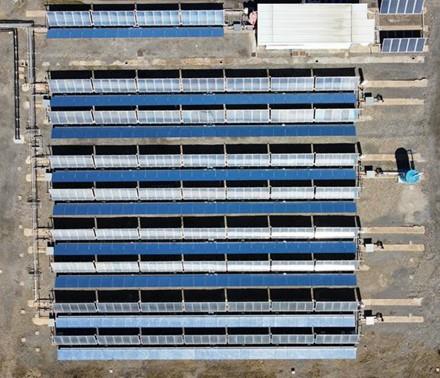

AQUASOL
Test-Bed for Solar Thermal Applications
The purpose of this facility is the study of the efficiency of large-aperture static solar collectors and its behaviour in the coupling with thermal energy systems 60-90 °C temperature levels.
The collector model installed is an LBM 10HTF with an aperture area of 10.1 m2, manufactured by Wagner & Co. The static solar field is composed of 60 collectors with a total aperture area of 606 m2 and a total thermal power output of 323 kWth under nominal conditions (efficiency of 59 % for 900 W/m2 global irradiance and 75 °C as average collector temperature).
It consists of 4 loops with 14 large-aperture flat plate collectors each (two rows connected in series per loop with 7 collectors in parallel per row), and one additional smaller loop with 4 collectors connected in parallel, all of them titled 35° south orientation. The solar field has rows of moving flat mirrors installed at the south of every row of collectors, they can track the Sun and reflect it, enhancing the radiation on each collector. This way, the effective aperture of the solar field can be augmented by 40 % using the same collector surface area. The five loops of collectors are connected with a thermal storage system through a heat exchanger. The thermal storage system consists of two connected water tanks for a total storage capacity of 40 m3. This volume allows sufficient operational autonomy for the fossil backup system to reach nominal operating conditions in the desalination plant. The facility has an air cooler that allows the entire energy dissipation from the solar field, which is useful for efficiency tests at different temperature levels.

The flexibility of the solar field allows the operation of each loop independently, through their own valves and pumping system. Each loop is connected to an individual heat exchanger that offers the possibility of coupling it with any low-temperature thermal energy-consuming device for testing purposes. Two of these loops are currently connected to heat distribution systems to supply thermal energy to membrane distillation test-beds and brine concentration pilot plants.